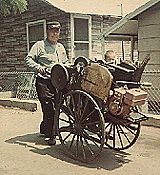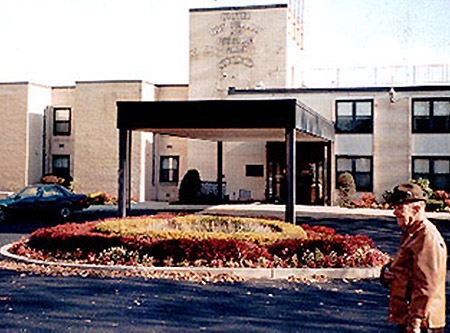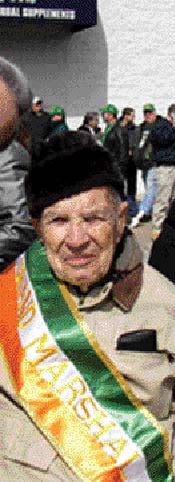The last page turned this week on the storied life of Bronx historian John McNamara, as the noted author, lifelong adventurer and walking encyclopedia of borough facts and lore died at the age of 91.
McNamara, a longtime contributor to the Bronx Times Reporter, died October 15 after a battle with cancer and other ailments. The author of several books, including History in Asphalt, which details the origins of street names in the Bronx, McNamara is being mourned by many this week, but also fondly remembered for his zest for life and passion for history, particularly of his native borough, that he shared in countless columns, conversations, lectures and books. "He loved the Bronx, he loved its history, he loved exploring, traveling and learning, but most of all, he loved sharing his knowledge and experiences with anyone and everyone," said McNamara’s son, John. "He touched a lot of lives, and so many people have told me that they learned so much about the borough, past and present, from my father, and shared with me how his love of the Bronx and Bronx history sparked their interest and passion for it over the years."
According to close friend and fellow borough historian Bill Twomey, one of the most intriguing aspects of McNamara’s vast and inimitable knowledge of the Bronx is how he obtained it. His interest in the history of the borough can be traced to a canoe trip McNamara took as a youngster. Born in 1912 in Melrose, his family obtained a summer bungalow in Edgewater Park in 1916, affording McNamara the opportunity to grow up in two divergent areas of the Bronx. It was during one of his early forays through the waterways of the borough that a young McNamara was stopped as he was carrying a canoe over the small neck of land connecting Fort Schuyler to the mainland in Throggs Neck, and a local lighthouse keeper, Captain Charles Ferreira, told him how long ago, Native Americans had basically traversed the area in much the same way. That tidbit of information sparked McNamara’s interest in Native American history in the area, and when street signs began to be erected in the Bronx in the 1920s, his interest in history was further piqued. "He began studying street names and eventually walked every street and byway in the borough and canoed or kayaked every waterway," Twomey explained. "He kept meticulous notes, and in 1978 published his grand collection in his book History in Asphalt." Most historians now consider that book as the most important contemporary work published on the Bronx. McNamara also penned three other books: McNamara’s Old Bronx, a collection of his newspaper columns in the Bronx Times Reporter and earlier in the Bronx Press Review; and two books he co-authored with Twomey, Throggs Neck Memories in 1994 and Throggs Neck-Pelham Bay in 1998. He wrote continued to write columns on the history of the borough for the Bronx Times Reporter until December 2000.
McNamara’s son pointed out that although his father was known to many for his writing, more often than not, he complemented his academic research with hands-on exploration. "There were so many times when my father would say he had to go see a street or a neighborhood or visit somebody who had an old photo or some information, and as a kid, I’d just hop on my bike and he’d get on his, and off we went," McNamara, Jr. said. "Most of the time, I was happy to have the chance to go for a good, long bike ride and spend time with my father. It wasn’t until many years later that I realized that in most cases, when we weren’t exploring history, we were living it." One notable example of that was a cold January morning in 1961, when McNamara awoke his teenage son, applied some grease to both their faces to ward off the frigid temperatures and frosty winds, and set out on their bicycles for the Throgs Neck Bridge, which had yet to open to the public. After making a deal with a watchman, the father and son pedaled across the span, becoming the first people to cross the bridge by bicycle even before it officially opened. Although he lived most of his life in the Bronx, marrying a local girl, Pauline Ungerer, and raising their son and daughter in Edgewater Park while he worked for the NYC Housing Authority, his adventures and extensive travels took him around the country and the globe. Before settling down, McNamara "rode the rails" throughout the U.S., chronicling many of his travels and experiences as a self-described "hobo journalist." He also served in the Philippines in the Army, and prior to the United States’ involvement in World War II, traveled throughout Nazi Germany. Earlier, he took one of his most extensive trips, walking miles through Ireland and visiting the birthplace of his grandparents in County Clare. He also traveled to such exotic destinations as the outback of Australia, South Africa, China, Russia, other European countries, and South America, which he recounted in numerous columns and essays over the years.
He was one of the founding fathers of the Bronx County Historical Society, and served as an active member of many other groups including the Bronx Old Timers Society, the Kingsbridge Historical Society and the American Name Society. In addition to a stint as a tour guide at the United Nations, on the local level, he served as a volunteer fireman, a scout leader and in other capacities at various points in his life. During the scores of walking tours, lectures and informal discussions he led regarding Bronx history, it was obvious that his passion for his subject matter was as rich and extensive as his knowledge of the topic. McNamara’s commitment and contributions to the borough, particularly in regard to chronicling its history, resulted in a number of awards and recognition. Most notably, in 1985, a square on the north service road of the Cross Bronx Expressway extension between Randall and Calhoun avenues was named in his honor. Despite his failing health, McNamara recently visited the square, which has been landscaped and planted. In 2000, McNamara was chosen to serve as grand marshal of the Throggs Neck St. Patrick’s Day Parade. McNamara was waked at Schuyler Hill Funeral Home on Sunday and Monday, and cremated on October 19 following a private memorial service.
Return to NYCHS home page. <---------------> To The Bronx Times Reporter home page. |



